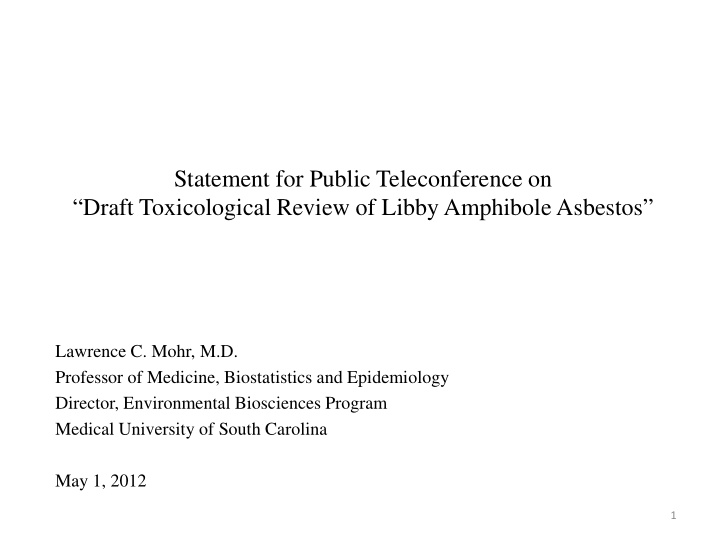



Statement for Public Teleconference on “Draft Toxicological Review of Libby Amphibole Asbestos” Lawrence C. Mohr, M.D. Professor of Medicine, Biostatistics and Epidemiology Director, Environmental Biosciences Program Medical University of South Carolina May 1, 2012 1
Localized Pleural Thickening (Pleural Plaques) Localized pleural thickening (pleural plaques) consists of one or more • benign, fibrotic growths on the parietal pleura of the interior chest wall. Localized pleural thickening is a reliable, benign marker of asbestos • exposure that has been reported in up to 50% of workers exposed to asbestos. In general, the total area of the parietal pleura involved with localized pleural thickening is related to the cumulative total dose of inhaled asbestos fibers. Localized pleural thickening has no further pathobiological potential. That • is, it does not transform into anything else and it is not a cause of asbestos- related diseases, such as mesothelioma, lung cancer and asbestosis. Localized pleural thickening is not in the pathobiological pathway for the • development of any benign or malignant asbestos-related disease, such as mesothelioma, lung cancer or asbestosis. 2
Localized Pleural Thickening (Pleural Plaques) (cont.) Subpleural fat can be mistaken for localized pleural thickening on chest • radiographs, even by the most astute and experienced radiologists. The preponderance of evidence indicates that localized pleural thickening, in • and of itself, does not cause statistically significant or clinically significant impairment of lung function. It is generally thought, and the literature suggests, that any impairment in • lung function that occurs among individuals with localized pleural thickening is most likely caused by coexisting, subradiographic interstitial fibrosis (asbestosis) and is not caused by the localized pleural thickening, per se. 3
Localized Pleural Thickening (Pleural Plaques) (cont.) Localized pleural thickening is almost always asymptomatic. This is the position • of the British Thoracic Society and the U.S. ATSDR. Overweight and obese individuals can have restrictive ventilatory impairment due • to increased body mass alone. Since a relatively large number of asbestos- exposed individuals in the Libby cohort were overweight or obese by body mass index (BMI), this could be the cause of “restrictive spirometry” in reported studies involving individuals with localized pleural thickening in this cohort. Chest pain or chest discomfort among individuals with localized pleural • thickening is rare and may not be caused by the localized pleural thickening, per se. Whenever an individual with localized pleural thickening presents with chest pain or chest discomfort, a thorough evaluation for other etiologies of the pain or discomfort should be performed. This is especially true of angina pectoris related to coronary artery disease. There are conflicting reports of the efficacy of localized pleural thickening as a • marker for the risk of developing asbestos-related diseases, such as mesothelioma, lung cancer and asbestosis. The potential risks of developing these asbestos-related diseases among individuals with pleural plaques are poorly understood and have never been quantified by formal risk assessments. 4
Recommend
More recommend